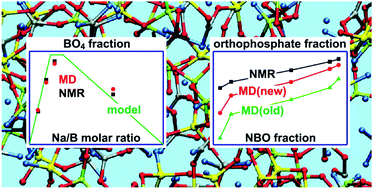Structure–composition trends in multicomponent borosilicate-based glasses deduced from molecular dynamics simulations with improved B–O and P–O force fields†
Abstract
We present a comprehensive molecular dynamics (MD) simulation study of composition–structure trends in a set of 25 glasses of widely spanning compositions from the following four systems of increasing complexity: Na2O–B2O3, Na2O–B2O3–SiO2, Na2O–CaO–SiO2–P2O5, and Na2O–CaO–B2O3–SiO2–P2O5. The simulations involved new B–O and P–O potential parameters developed within the polarizable shell-model framework, thereby combining the beneficial features of an overall high accuracy and excellent transferability among different glass systems and compositions: this was confirmed by the good accordance with experimental data on the relative BO3/BO4 populations in borate and boro(phospho)silicate networks, as well as with the orthophosphate fractions in bioactive (boro)phosphosilicate glasses, which is believed to strongly influence their bone-bonding properties. The bearing of the simulated melt-cooling rate on the borate/phosphate speciations is discussed. Each local {BO3, BO4, SiO4, PO4} coordination environment remained independent of the precise set of co-existing network formers, while all trends observed in bond-lengths/angles mainly reflected the glass-network polymerization, i.e., the relative amounts of bridging oxygen (BO) and non-bridging oxygen (NBO) species. The structural roles of the Na+/Ca2+ cations were also probed, targeting their local coordination environments and their relative preferences to associate with the various borate, silicate, and phosphate moieties. We evaluate and discuss the common classification of alkali/alkaline-earth metal ions as charge-compensators of either BO4 tetrahedra or NBO anions in borosilicate glasses, also encompassing the less explored NBO-rich regime: the Na+/Ca2+ cations mainly associate with BO/NBO species of SiO4/BO3 groups, with significant relative Na–BO4 contacts only observed in B-rich glass networks devoid of NBO species, whereas NBO-rich glass networks also reveal substantial amounts of NBO-bearing BO4 tetrahedra.



 Please wait while we load your content...
Please wait while we load your content...